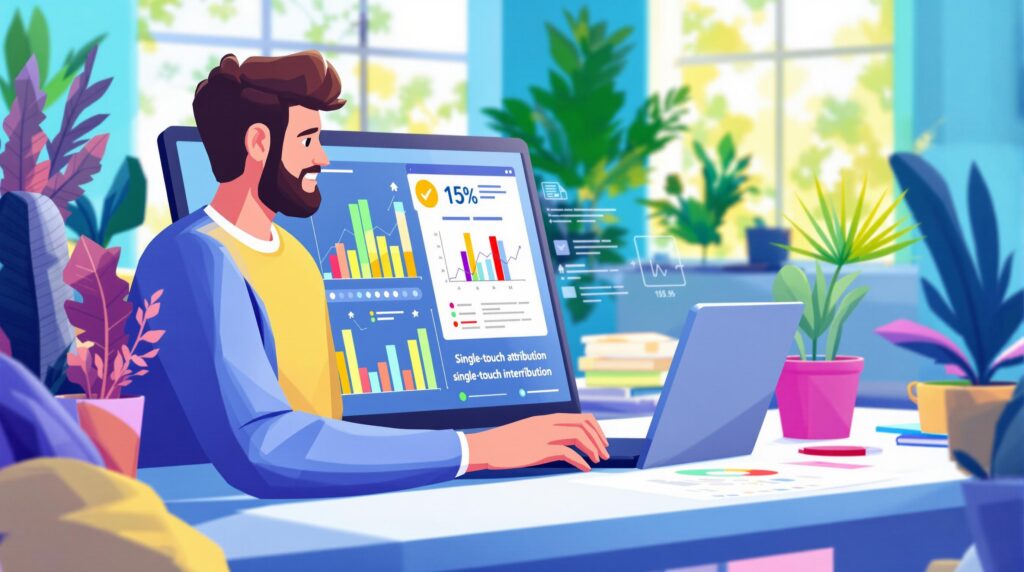Single-touch attribution is a simple way to measure marketing success by giving all credit for a conversion to one interaction in the customer journey. It helps businesses identify which touchpoint – like an ad click or email – is driving results. This model is easy to set up and ideal for small businesses with straightforward sales processes.
Key Takeaways:
- What It Does: Tracks and credits one touchpoint for conversions (e.g., first or last interaction).
- Who Benefits: Small businesses or those new to analytics.
- Models:
- First-Touch: Focuses on awareness and lead generation.
- Last-Touch: Highlights what closes sales.
- Last Non-Direct Touch: Evaluates multi-channel campaigns.
- Pros: Easy, cost-effective, clear insights.
- Cons: Oversimplifies the customer journey, ignores other touchpoints.
If you’re starting with marketing analytics, single-touch attribution is a practical way to pinpoint what works and allocate your budget wisely.
How Single-Touch Attribution Works
Tracking Customer Interactions
Single-touch attribution tracks customer interactions across various marketing channels like ad clicks, email responses, website visits, and social media engagements. Tools such as Google Analytics make this process straightforward by automatically gathering data on user activity.
Assigning Credit to One Touchpoint
This approach assigns all conversion credit to a single interaction, depending on the model you select (e.g., first touch or last touch). Let’s say a customer sees a Facebook ad, clicks on an email, and then makes a purchase. Under a last-touch model, the email interaction would receive full credit [2]. Tools like analytics platforms handle this automatically, tracking interactions and producing reports to pinpoint which channels are driving results [1].
Here’s how it works in three steps:
- Data Collection: Customer interactions across channels are monitored and recorded.
- Model Application: The chosen single-touch model determines which interaction gets the credit.
- Analysis and Reporting: Reports are generated to reveal which touchpoints contribute to conversions [1].
While single-touch attribution doesn’t capture the full complexity of a customer’s journey, its straightforward approach offers clear insights. These insights can help businesses adjust their marketing strategies to focus on what’s working [1][5].
Now that you know how single-touch attribution operates, let’s dive into the specific models businesses rely on.
Single Touch Attribution
Types of Single-Touch Attribution Models
Single-touch attribution models offer a simple way for small and medium businesses to measure marketing performance. Each model focuses on a single point in the customer journey, offering specific insights into how marketing efforts contribute to conversions.
First Touch Attribution
First Touch Attribution assigns all credit for a conversion to the first interaction a customer has with your brand. This model is useful for pinpointing which channels are effective at creating brand awareness and bringing in new leads [2]. It helps marketers understand:
- Which channels successfully attract new prospects
- Activities that drive initial interest
- Early touchpoints that lead to conversions
Last Touch Attribution
Last Touch Attribution gives 100% credit to the final interaction before a conversion. This model is designed to spotlight the channels and activities that directly influence purchase decisions [2]. It provides insights such as:
- Which channels are most effective at closing sales
- Factors that drive final purchase decisions
- Activities directly tied to revenue generation
Last Non-Direct Touch Attribution
This model credits the last marketing channel before a direct visit (when a customer directly types your website URL). It’s particularly helpful for evaluating the performance of multi-channel campaigns without giving credit to direct traffic [2][3]. This approach is useful for:
- Assessing the effectiveness of marketing campaigns across different platforms
- Understanding which channels contribute to conversions
- Measuring the success of specific marketing efforts
| Attribution Model | Ideal For | Key Insight |
|---|---|---|
| First Touch | Lead Generation | Identifies channels driving awareness |
| Last Touch | Sales | Highlights triggers for conversion |
| Last Non-Direct Touch | Multi-Channel | Evaluates cross-platform campaigns |
Each of these models can provide helpful insights, but they also have their limitations. Knowing their strengths and weaknesses is crucial for making better marketing decisions [1][3].
sbb-itb-2ec70df
Pros and Cons of Single-Touch Attribution
Advantages of Single-Touch Attribution
Single-touch attribution is easy to implement and doesn’t require a lot of technical know-how or resources [1]. This makes it a good choice for businesses that don’t have access to advanced tools or large marketing teams.
It provides quick insights into which touchpoints are driving conversions, allowing businesses to make faster decisions about where to spend their marketing budget [1][2]. For companies with straightforward customer journeys or fewer marketing channels, this model can highlight the most important conversion drivers without overcomplicating things.
Since it demands fewer resources compared to multi-touch models, it’s an appealing option for small and medium-sized businesses working with tighter budgets and limited analytics capabilities [1].
Drawbacks of Single-Touch Attribution
One major downside is that it doesn’t account for the influence of multiple channels [2][5]. Customers often interact with several touchpoints before making a purchase, and this model tends to oversimplify those interactions.
By focusing on just one touchpoint, businesses risk making incomplete decisions and misallocating their resources [2]. It can lead to undervaluing or ignoring other channels that play a role in driving conversions. This limitation is especially challenging for companies with complex marketing strategies that span multiple campaigns and platforms.
Weighing these pros and cons is crucial when deciding if single-touch attribution fits your business. While it’s a good starting point for attribution, businesses should think about how their marketing needs might grow and whether they’ll need a more advanced model in the future.
Summary of Pros and Cons
| Aspect | Advantages | Drawbacks |
|---|---|---|
| Implementation | Easy and quick to set up | Oversimplifies complex customer paths |
| Resource Needs | Cost-effective, low maintenance | Limited analytical depth |
| Data Insights | Clear and actionable insights | Overlooks contributions from other channels |
| Decision-Making | Allows faster optimizations | Could lead to incomplete strategies |
How Small and Medium Businesses Can Use Single-Touch Attribution
Leveraging Single-Touch Attribution for Insights
Small and medium businesses can use single-touch attribution to pinpoint what drives conversions and allocate resources more effectively. Tools like Google Analytics make this possible without needing complex setups [1]. For lead generation businesses, focusing on first-touch attribution can highlight which channels bring in potential customers. On the other hand, e-commerce businesses often benefit from last-touch attribution, which identifies the final interactions that lead to purchases [1][2].
Real-World Applications of Single-Touch Attribution
Once you’ve identified the key drivers of your conversions, here’s how businesses can apply single-touch attribution:
| Business Type | Attribution Focus | Key Metrics |
|---|---|---|
| E-commerce | Last-touch | Channels leading to purchases |
| Lead Generation | First-touch | Sources attracting new leads |
| Service Business | Last Non-Direct | Referral sources driving actions |
To make the most of single-touch attribution:
- Focus on interactions that matter most to your brand.
- Choose the conversion points that align with your goals.
- Collect and analyze data from these specific touchpoints [1].
How Growth-onomics Supports Businesses

While single-touch attribution provides useful insights, it doesn’t capture the full customer journey. Growth-onomics steps in to fill these gaps, combining customer journey mapping with advanced data analysis.
Growth-onomics offers:
- Help setting up attribution tracking
- Expert data analysis services
- Strategies to boost ROI
- Campaign improvements to increase conversions
This approach ensures businesses get the most out of single-touch attribution while setting the stage for more advanced measurement tools as they expand [2][5].
Conclusion
Key Takeaways
Single-touch attribution is a straightforward way for small businesses to evaluate marketing performance. By giving all the credit to a single point in the customer journey – like the first interaction, last click, or last non-direct touch – it provides a clear view of how specific touchpoints contribute to conversions [1]. This approach is easy to set up and offers practical insights to help allocate resources and make informed decisions.
It’s particularly useful for businesses with simple customer journeys or those just starting with attribution [2]. Grasping these basics can guide smarter marketing strategies.
How to Begin
If you’re ready to implement single-touch attribution, follow these steps:
-
Pick Your Model and Set Up Tracking
- Decide on the most relevant model for your business (e.g., first-touch for lead generation or last-touch for e-commerce).
- Use tools like Google Analytics to set up tracking [2].
-
Monitor and Improve
- Keep an eye on key metrics such as conversion rates, click-through rates, ROI, and customer acquisition costs.
- Regularly review your data to spot trends and tweak your marketing strategy [1].
- As your business expands, explore more advanced attribution models to better capture the complexity of your customer journeys [2].
Over time, as your marketing efforts grow in complexity, refining your attribution approach will help you gain a more complete understanding of what drives results [3]. Regular analysis and adjustments will ensure your strategy stays effective.
FAQs
What is single-touch attribution?
Single-touch attribution assigns credit for a conversion to just one touchpoint in the customer journey [1]. For examples and practical uses, see the earlier section on attribution models.
How do different single-touch models compare?
Each model fits different goals: first-touch highlights how customers discover your brand, last-touch ties conversions directly to the final interaction, and last non-direct touch evaluates campaign performance across platforms [2]. The best choice depends on your marketing goals and the complexity of your customer journey.
What tools support single-touch attribution?
Both Google Analytics and Adobe Analytics are popular tools for tracking attribution. Google Analytics supports first and last-touch models, while Adobe Analytics offers additional options for more in-depth analysis [3].
When should I use single-touch attribution and what are its limitations?
This approach works well for smaller businesses with straightforward customer journeys or single-channel campaigns [4]. However, it simplifies the path to conversion and can miss other influential touchpoints [2][3]. Evaluate your marketing strategy and resources to decide if it’s the right fit.
How accurate is single-touch attribution?
It’s reliable for straightforward campaigns with direct customer paths but less effective for multi-channel or complex marketing setups [6].
For more details on implementation and best practices, check earlier sections of this guide. These FAQs provide a solid starting point for understanding single-touch attribution.









